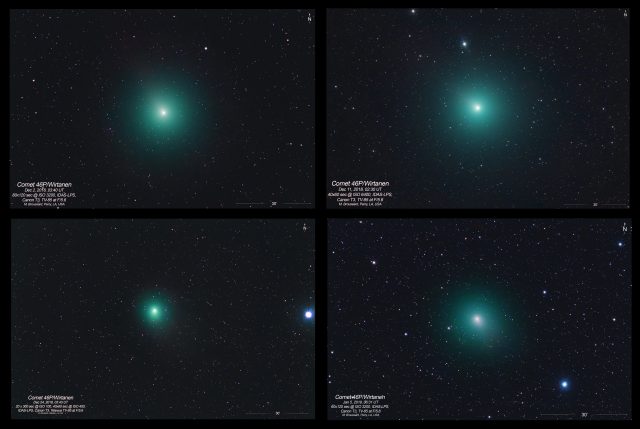 So far, I’ve managed to image Comet 46P/Wirtanen four times during this apparition with my TV-85 scope and twice with camera lenses. For this time of the year, that is pretty good. December and January are usually months of unending rain and clouds down here in Cajun Country.
So far, I’ve managed to image Comet 46P/Wirtanen four times during this apparition with my TV-85 scope and twice with camera lenses. For this time of the year, that is pretty good. December and January are usually months of unending rain and clouds down here in Cajun Country.
Now that the main part of Comet Wirtanen’s visit is over, it is a good time to do a roundup of the data and see the bigger picture. So, I took the best four star-freeze versions from those four times with the telescope and combined them into one display image above. That way, you can easily compare the shape of the comet and see how it changed depending on our angle of view at the time.
The dust and ion tails were both mostly hidden behind the huge coma on this comet. It was huge because it was so close to us. But, since it was still further from the Sun than we are and the Sun, Earth and comet were in a line, the tails were pointing directly away from us. That foreshortens the length of the tail and makes it look like it doesn’t even have one at times. It is just the geometry of the view angle and the way the coma can overwhelm the dim tails when they are behind it from our vantage point.
When we were more at an angle to the Sun-comet angle, the tail appeared longer. When we were in-line with it and the Sun, the tail decreased. So, it is not totally comet activity at this point that controls tail length, it is view angle and how much is behind a thick coma. You still have the solar wind and how chaotic it is that causes the tail to “flap” like a flag when the wind varies. But, mostly view angle.
46P came in low going high and crossed our orbit then angled above the elliptic plane heading away from the Sun. Our view now is from underneath, you would say. That is why the tail is south now when it was mostly on the north side when it was below the elliptic.
